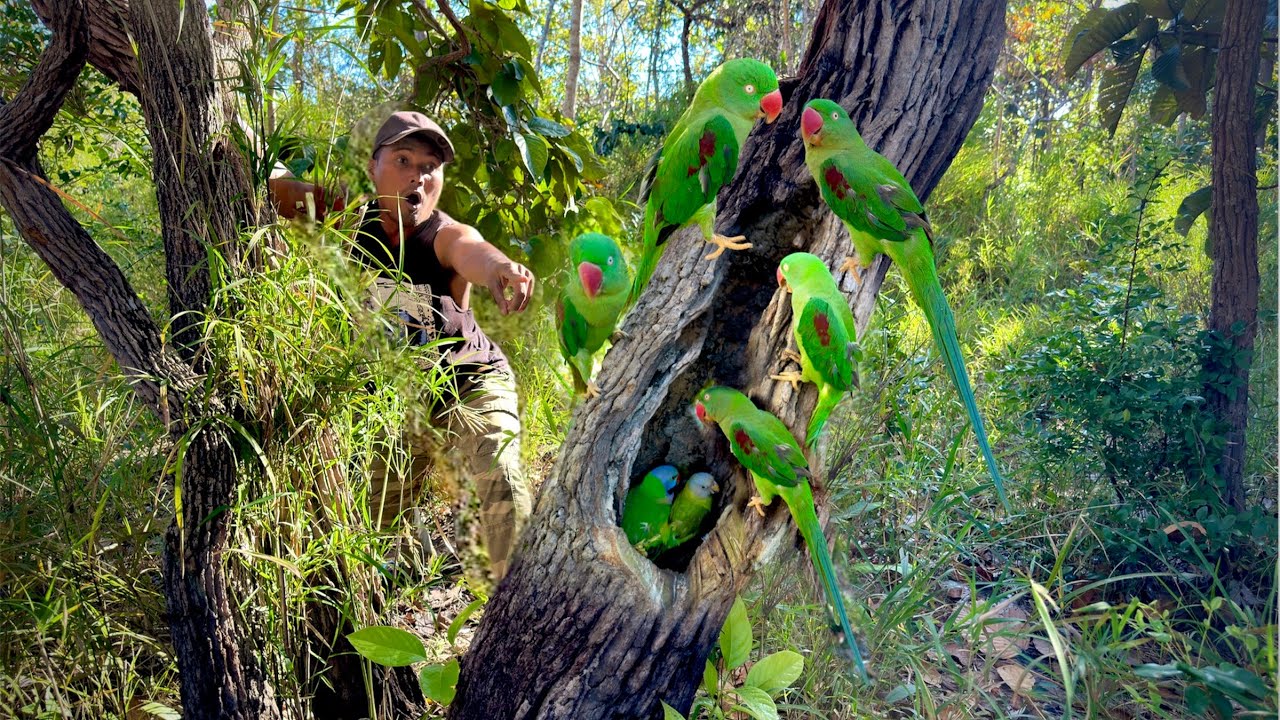Introduction to Parrot Catching

Catching a parrot can be a thrilling yet challenging experience. Whether you're trying to bring a runaway pet back home or looking to capture a wild parrot for observation, understanding the process is key. In this guide, we’ll walk you through the essentials of safely and humanely catching a parrot, ensuring both you and the bird remain calm throughout the experience. Grab your favorite snack and let’s dive into the fascinating world of parrot catching!
Also Read This: How to Make Coffee in Coffee Maker: Easy Step-by-Step Guide on Dailymotion
Understanding Parrot Behavior

To successfully catch a parrot, it’s crucial to understand their behavior. Parrots are intelligent, social creatures with unique personalities. Here are some essential aspects of their behavior to consider:
- Curiosity: Parrots are naturally curious. They explore their surroundings and may approach you if they feel safe.
- Flight Response: Their instinct is to fly away from perceived threats. This means you need to approach them calmly and slowly.
- Bonding: Parrots often form strong bonds with humans. If you’re a familiar face, they may trust you more, making it easier to catch them.
- Playfulness: They enjoy play and can be distracted with toys or treats, which can be useful when trying to catch them.
When observing parrots, take note of their body language. For example:
| Body Language | Meaning |
|---|---|
| Fluffed feathers | Feeling relaxed or comfortable |
| Wide eyes | Curious or alert |
| Head bobbing | Excitement or playfulness |
| Backing away | Feeling threatened or scared |
Understanding these behaviors will not only help you catch a parrot but also ensure that the process is as stress-free as possible for both you and the bird. Remember, patience is key! Each parrot has its own personality, so take your time to observe and adapt your approach accordingly.
Also Read This: How to Block a Channel on YouTube and Manage Your Feed Effectively
3. Essential Tools for Catching a Parrot
Before you embark on your parrot-catching adventure, it's crucial to have the right tools at your disposal. Think of these items as your trusty sidekicks, each playing a vital role in making the process smooth and safe for both you and the bird. Here’s a handy list of essential tools you’ll need:
- Bird Net: A humane bird net is a must-have. Opt for one that has a soft mesh to prevent harming the parrot. Look for nets with a long handle, making it easier to reach higher branches.
- Food Bait: Parrots are food-oriented creatures. Use their favorite treats like sunflower seeds, nuts, or even slices of fruit to lure them closer. A little patience goes a long way!
- Trap or Aviary: If you’re trying to catch a parrot that’s already in the wild or a large space, a small aviary or a trap can be effective. Ensure it has a comfortable space for the bird to feel at ease.
- Gloves: Wearing gloves can protect your hands from bites and ensure a secure grip. Choose gloves that offer dexterity but also enough protection.
- Binoculars: These are useful for spotting parrots from a distance without scaring them away. Look for lightweight options so you can carry them easily.
- Water Container: If you’re out for an extended period, having a small water container will help keep the bird hydrated once you’ve caught it.
Having these tools ready will not only increase your chances of successfully catching a parrot but also ensure that you do it in a way that's safe and respectful to the bird and its environment. Now, let’s roll up our sleeves and get into the nitty-gritty of the actual catching process!
Also Read This: How to Make Crochet Baby Frocks: Fun DIY Tutorial on Dailymotion
4. Step-by-Step Instructions
Alright, it’s time to get hands-on! Here’s a detailed step-by-step guide to help you catch a parrot in the most efficient and humane way. Follow these instructions closely, and you’ll be well on your way to achieving your goal:
- Observe and Identify: Spend some time watching the parrot. Identify its favorite perching spots, feeding routines, and behaviors. This information is invaluable and will help you plan your approach.
- Set Up Your Bait: Choose a spot near where you’ve seen the parrot and set up food bait. Scatter some treats on the ground or place them inside a trap. This will entice the bird to come down from its perch.
- Be Patient: This step requires a lot of patience. Stay quiet and keep your distance. Avoid sudden movements that might scare the bird away. It may take some time for the parrot to feel safe enough to approach the bait.
- Use the Net: Once the parrot is close enough to the bait, carefully approach with your bird net. Slowly and gently position the net over the bird. Quick and sudden movements can frighten it, so take your time.
- Catch the Bird: When the parrot is within reach, gently lower the net over it. Make sure to secure the net’s edges to prevent the bird from escaping. You want to ensure it feels more trapped than scared.
- Handle with Care: Once you’ve caught the parrot, gently lift the net and carefully reach in to hold the bird. Use your gloved hand to support its body and avoid holding its wings tightly, which may cause stress.
- Transfer to a Safe Space: Place the parrot in a secure and comfortable container or aviary. Make sure it has enough ventilation and space to move around. This helps reduce stress for the bird.
Remember, the key to successfully catching a parrot is to be calm, patient, and respectful of its natural behavior. Celebrate your success, but always keep in mind the well-being of the feathered friend you’ve just caught!
Also Read This: How to Turn Off Family Filter on Dailymotion for Unrestricted Access
5. Safety Tips for You and the Parrot
When it comes to catching a parrot, safety should be your top priority—both for you and for the little feathered friend you're trying to catch. Here are some essential safety tips to keep in mind:
- Stay Calm: Parrots are naturally skittish creatures. If you’re anxious, the parrot will sense this and become more agitated. Take deep breaths and approach the situation with a calm demeanor.
- Use the Right Tools: Always have the right catching tools on hand, such as a net designed for birds or a soft towel. Avoid rigid or sharp-edged items that could harm the parrot.
- Watch for Hazards: Before you attempt to catch the parrot, survey the area for potential hazards. Look for open windows, sharp objects, or busy roads nearby. Create a safe space where the parrot can be contained without the risk of injury.
- Wear Protective Gear: Depending on the situation, consider wearing gloves to protect your hands from bites, as even the friendliest parrot might bite if they feel threatened. A long-sleeve shirt can also offer some protection.
- Have a Plan: Think ahead about what you will do once you catch the parrot. Have a safe cage or a designated area ready to place the bird immediately after catching it to minimize stress.
By following these safety tips, you’ll ensure that both you and the parrot stay safe during the catching process. Remember, the goal is to create a peaceful and stress-free environment for everyone involved.
6. What to Do After Catching a Parrot
Congratulations! You’ve successfully caught a parrot. Now, it’s crucial to handle the situation with care to ensure the parrot’s well-being and your own. Here’s a step-by-step guide on what to do next:
- Place the Parrot in a Safe Cage: Immediately transfer the parrot to a secure cage that is well-ventilated and appropriately sized. Ensure it has food and water available, so it can start to relax after the stress of being caught.
- Give It Time to Adjust: Allow the parrot some time to calm down in its new environment. Limit interaction at first; just let it explore its cage and get used to its surroundings.
- Monitor Its Behavior: Keep an eye on the parrot for signs of stress or illness. Look for changes in eating habits, vocalization, or movement. If something seems off, consult a vet who specializes in birds.
- Provide Enrichment: Once the parrot seems settled, slowly introduce toys and perches into its cage. Parrots are intelligent and need stimulation to stay happy. Offering a variety of toys can help reduce stress and prevent boredom.
- Consider Socialization: If the parrot seems comfortable after a few days, you can start to socialize it. Approach it gently, speak softly, and offer treats to build trust. Gradually increase your interactions as the parrot becomes more accustomed to you.
Handling a newly caught parrot with care is essential for its well-being. By following these steps, you’ll help create a nurturing environment that ensures a smooth transition for your new feathered friend!
 admin
admin








